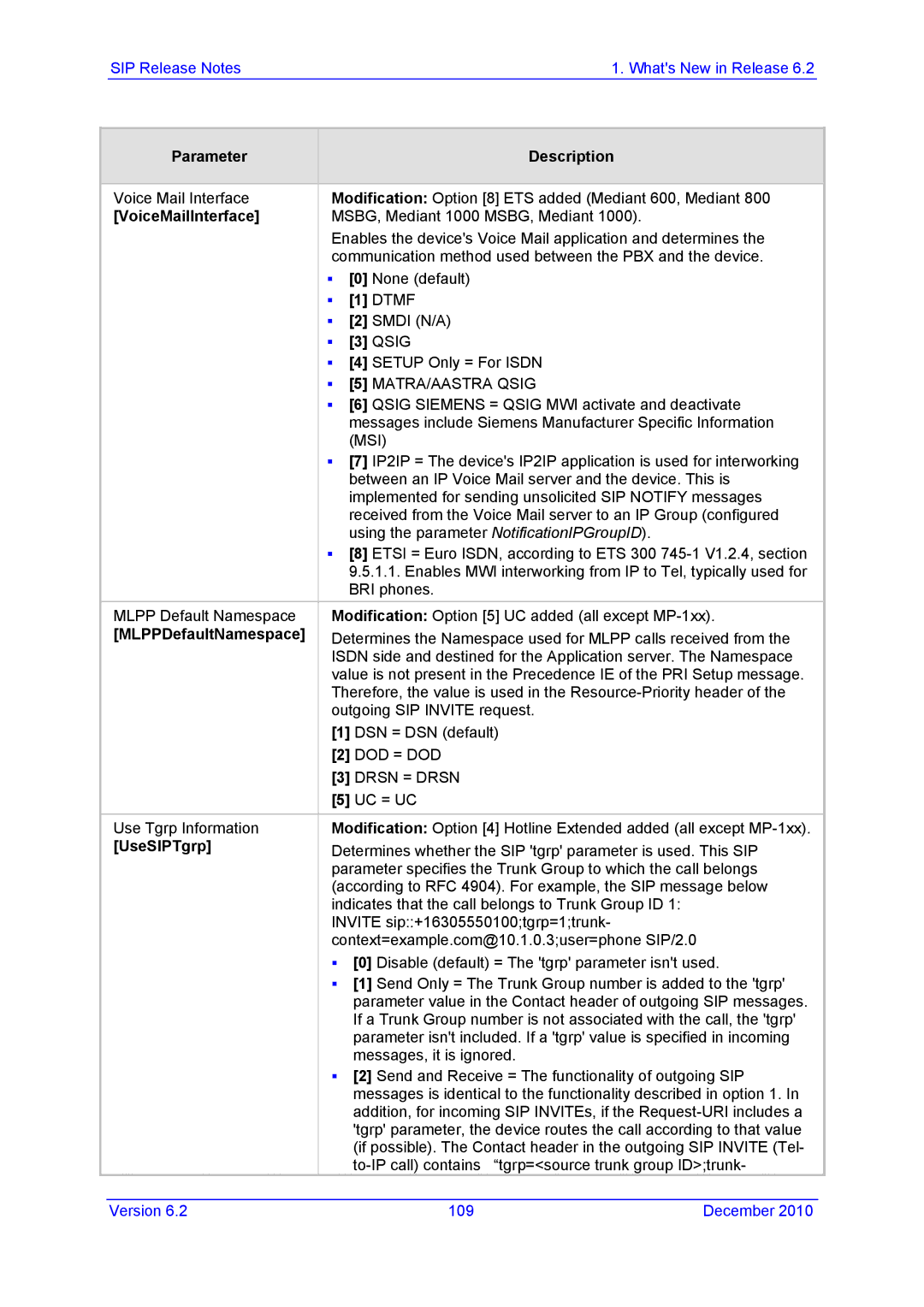| SIP Release Notes | 1. What's New in Release 6.2 |
|
|
|
|
|
| Parameter | Description |
|
|
|
|
|
| Voice Mail Interface | Modification: Option [8] ETS added (Mediant 600, Mediant 800 |
|
| [VoiceMailInterface] | MSBG, Mediant 1000 MSBG, Mediant 1000). |
|
|
| Enables the device's Voice Mail application and determines the |
|
|
| communication method used between the PBX and the device. |
|
|
| [0] None (default) |
|
|
| [1] DTMF |
|
|
| [2] SMDI (N/A) |
|
|
| [3] QSIG |
|
|
| [4] SETUP Only = For ISDN |
|
|
| [5] MATRA/AASTRA QSIG |
|
|
| [6] QSIG SIEMENS = QSIG MWI activate and deactivate |
|
|
| messages include Siemens Manufacturer Specific Information |
|
|
| (MSI) |
|
|
| [7] IP2IP = The device's IP2IP application is used for interworking |
|
|
| between an IP Voice Mail server and the device. This is |
|
|
| implemented for sending unsolicited SIP NOTIFY messages |
|
|
| received from the Voice Mail server to an IP Group (configured |
|
|
| using the parameter NotificationIPGroupID). |
|
|
| [8] ETSI = Euro ISDN, according to ETS 300 |
|
|
| 9.5.1.1. Enables MWI interworking from IP to Tel, typically used for |
|
|
| BRI phones. |
|
| MLPP Default Namespace | Modification: Option [5] UC added (all except |
|
| [MLPPDefaultNamespace] | Determines the Namespace used for MLPP calls received from the |
|
|
| ISDN side and destined for the Application server. The Namespace |
|
|
| value is not present in the Precedence IE of the PRI Setup message. |
|
|
| Therefore, the value is used in the |
|
|
| outgoing SIP INVITE request. |
|
|
| [1] DSN = DSN (default) |
|
|
| [2] DOD = DOD |
|
|
| [3] DRSN = DRSN |
|
|
| [5] UC = UC |
|
|
|
|
|
| Use Tgrp Information | Modification: Option [4] Hotline Extended added (all except |
|
| [UseSIPTgrp] | Determines whether the SIP 'tgrp' parameter is used. This SIP |
|
|
| parameter specifies the Trunk Group to which the call belongs |
|
|
| (according to RFC 4904). For example, the SIP message below |
|
|
| indicates that the call belongs to Trunk Group ID 1: |
|
|
| INVITE sip::+16305550100;tgrp=1;trunk- |
|
|
| context=example.com@10.1.0.3;user=phone SIP/2.0 |
|
|
| [0] Disable (default) = The 'tgrp' parameter isn't used. |
|
|
| [1] Send Only = The Trunk Group number is added to the 'tgrp' |
|
|
| parameter value in the Contact header of outgoing SIP messages. |
|
|
| If a Trunk Group number is not associated with the call, the 'tgrp' |
|
|
| parameter isn't included. If a 'tgrp' value is specified in incoming |
|
|
| messages, it is ignored. |
|
|
| [2] Send and Receive = The functionality of outgoing SIP |
|
|
| messages is identical to the functionality described in option 1. In |
|
|
| addition, for incoming SIP INVITEs, if the |
|
|
| 'tgrp' parameter, the device routes the call according to that value |
|
|
| (if possible). The Contact header in the outgoing SIP INVITE (Tel- |
|
|
|
|
Version 6.2 | 109 | December 2010 |
